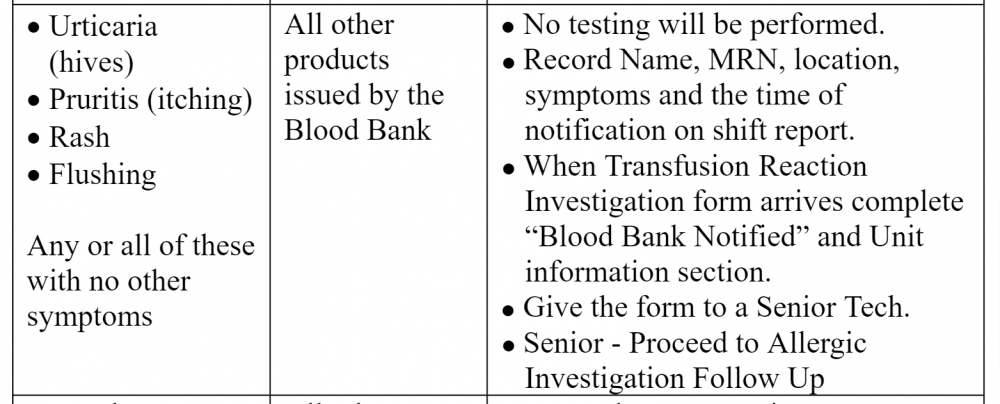Leaderboard
-
in all areas
- All areas
- Records
- Record Comments
- Record Reviews
- Jobs
- Jobs Comments
- Jobs Reviews
- Questions
- Question Comments
- Question Reviews
- Links
- Links Comments
- Files
- File Comments
- File Reviews
- Images
- Image Comments
- Albums
- Album Comments
- Records
- Record Comments
- Events
- Event Comments
- Blog Entries
- Blog Comments
- Topics
- Posts
- Status Updates
- Status Replies
-
Custom Date
-
All time
June 28 2007 - April 27 2024
-
Year
April 27 2023 - April 27 2024
-
Month
March 27 2024 - April 27 2024
-
Week
April 20 2024 - April 27 2024
-
Today
April 27 2024
-
Custom Date
07/07/2021 - 07/07/2021
-
All time
Popular Content
Showing content with the highest reputation on 07/07/2021 in all areas
-
Research letter in NEJM describes our findings. https://www.nejm.org/doi/full/10.1056/NEJMc2034764?fbclid=IwAR1BQRvpaHBAMDaHxCPY07xBjPQHlIHoJCOmpjoT_pBNvQsV7pzzDVdLYaY Table 1. HLA-Matched Platelets as a Percentage of All Platelet Transfusions, According to the Initiation of Other Protocols.* Protocol and Timing of Initiation No. of Years HLA-Matched Platelets Difference from Previous Period (95% CI) median % (IQR) percentage points No leukoreduction and no ABO matching (1985–1990) 6 12.5 (4.2–13.7) NA Leukoreduction and ABO matching for patients with leukemia and MDS (1991–1999)† 5 2.9 (2.0–3.6) 9.6 (9.4–9.8) Universal leukoreduction (2001–2004) 4 1.4 (1.1–2.0) 1.5 (1.4–1.6) Universal ABO matching (2005–2015) 11 0.4 (0.2–0.8) 1.0 (1.0–1.1) Pathogen reduction of platelets (2016–2019)‡ 4 1.7 (0.8–1.8) ND The practical fact is that this can only be implemented by medical technologists, not physicians, and this is a daunting prospect. But the reality is that ABO mismatched platelet transfusions probably exacerbate rather than prevent bleeding, so waiting for ABO identical is likely better than just transfusing whatever is available. This is going to require a major change of approach because the (incorrect) dogma, based upon no data, is that ABO doesn't matter for platelets. I understand why many people's instant reaction is this is not feasible. But it is once technical experts in your transfusion service figure out how to implement it gradually. In our randomized trial back in 1993 (see ref below), the ABO identical group only required <50% the number of platelet transfusions (every other day instead of every day on average) compared with the usual first in, first out regardless of ABO type group. ABO mismatched transfusions create a hostile environment with gigantic immune complexes that compromise subsequent transfusion that may be ABO identical. Avoiding this is key. Our suggestion is to start gradually. Pick new previously untransfused patients with aplastic anemia and good prognosis AML (young, favorable or normal cytogenetics), groups O or A, and start with them. Eminently doable since your platelet supply is 45% O and 40% A, just like your patients, on average. Get the hang of doing this and prioritizing ABO for at least some patients. Once you get this in place, extending it to other patients and eventually all patients can happen. We use washed O or A platelets and red cells for group B and AB recipients when we don't have group B or AB platelets. No increase in bleeding and fewer transfusion reactions, lung injury and congestive heart failure (what we call TRALI and TACO). In the end, you have more surviving patients and fewer headaches and transfuse many fewer platelets per patient and essentially no HLA if you can get your referring hospitals to stop our current standard harmful practices. Godspeed. Heal JM, Rowe JM, McMican A, Masel D, Finke C, Blumberg N. The role of ABO matching in platelet transfusion. Eur J Haematol. 1993 Feb;50(2):110-7. doi: 10.1111/j.1600-0609.1993.tb00150.x. PMID: 8440356. Happy to have discussions or visitors so our technical experts can show you how it is feasible.1 point
-
Cannot post the entire article due to copyright restrictions, but most institutions have access to NEJM through their library. If not, shoot me an email at neil_blumberg@urmc.rochester.edu and I'll send along the .pdf. If you are transfusing 40-60 platelets a day, giving ABO identical to group O and A individuals should be relatively easy. When patients are changing ABO blood group it becomes more difficult. We avoid transfusion ABO antigen and/or antibody that is incompatible with either original recipient type or donor type. Usually means washed group O red cells and platelets. That's the bad news. It does require time and effort, and as you say, med techs are in short supply. Here's the good news. If you transfuse ABO identical or washed compatible platelets you will use between 30-50% fewer platelets per patient, increasing your supply and decreasing your cost/problems. You will also use next to no HLA matched platelets (we used 3 out of 6,000 one recent year), you will have fewer febrile and allergic transfusion reactions, you will have fewer red cell as well as HLA antibodies made in recipients, and you may reduce TRALI and TACO. Obviously you have to have universal leukoreduction to start with. Selective leukoreduction misses about 50% of the patients who will become refractory, probably due to missed or delayed diagnosis of hematologic malignancy, aplastic anemia, etc. But the big attraction is you will have less bleeding, although that mainly affects the patients and the docs and nurses at the bedside. When you transfuse ABO major incompatible, which seems to be the default due to fear of hemolysis from minor incompatible, you don't get any increments, you use lots of platelets and the patients bleed more. (see references below) Bleeding causes lots of harm, but also impacts the blood transfusion service for obvious reasons. So figure out a way to start giving patients with aplastic anemia and acute myeloid leukemia who are newly diagnosed only ABO identical platelets and that will be a great start for the patients and the transfusion service. Those patients will bleed less, need fewer platelet transfusions, have fewer transfusion reactions, will not have positive DATs, and will likely survive their hospitalization and disease at higher rates if our experience is typical. And if you cannot give ABO identical or washed platelets free of incompatible cellular and soluble antigen and free of incompatible ABO antibody, start out with minor incompatible platelets (e.g., O to A) rather than ABO major incompatible (e.g., A to 0). The risks of hemolysis are not negligible (about 1 in 800) but are less serious and severe than having life threatening bleeding or refractoriness which occur more rapidly with ABO major incompatible in all likelihood. There's a ton of antibody that is incompatible with antigen transfused when we give A platelets to O recipients which means each antigen winds up with a ton of antibody making huge immune complexes. When we transfuse antibody incompatible we are transfusing a small amount of antibody into a recipient with huge amounts of antigen, so the size and number of immune complexes is probably smaller. These are my best guesses that we've been making exactly the wrong decision when we give ABO mismatched platelets. Best to avoid any, but major mismatched provides no hemostasis, minimal to no increment and is associated with increased bleeding mortality in the study from Columbia (David Roh and colleagues https://pubmed.ncbi.nlm.nih.gov/33649761/). But ABO identical is not that hard for larger centers for the 85% of patients who are group O or A. You just have to start small, get the hang of it, and then extend to other blood groups and other diseases than leukemia, MDS and aplastic anemia (including transplants, particularly allo--transplants). All those tables of how to select ABO mismatched platelets for transplant recipients are well intentioned but scientifically without evidence. Avoid infusing incompatible antigen and antibody as much as possible, and delay transfusion when ABO identical will be available within hours. Give priority to patient well being over inventory management. Give reduced doses, which work just as well. Get a Terumo or Haemonetics washing device and wash with PAS. It's a big set of changes, but neither terribly expensive nor rocket science. The dogmas and expert opinion about universal leukoreduction and ABO matching of transfusions are now proven to be tragically mistaken. https://www.ashclinicalnews.org/news/from-the-blood-journals/written-in-blood/outcomes-abo-incompatible-platelet-transfusions-patients-intracerebral-hemorrhage/ https://pubmed.ncbi.nlm.nih.gov/11399821/ https://pubmed.ncbi.nlm.nih.gov/21414009/1 point
-
1 point
-

Saline incubation...why is this SOP still allowed?
Joanne P. Scannell reacted to Mabel Adams for a topic
I just want to mention the saline titration procedures that are in the Technical Manual and that the CAP promotes as their preferred procedure. Their supporting paper will pretty clearly show that saline technique can detect antibodies (see the CAP website). I have seen many antibodies react when titrated by a saline technique.1 point -

Saline incubation...why is this SOP still allowed?
Joanne P. Scannell reacted to John C. Staley for a topic
I think I'll pass on joining this discussion since I am old, retired and can't possibly contribute, but thanks for asking.1 point -
Hi labgirl153, I won't weigh in with an opinion or facts regarding your question, I will ask that you reconsider your harsh tone toward some very smart people who are offering advice and their many years of experience. People here are not paid for the time they spend helping others, and responses such as your will lessen their willingness to continue. Remember, You can catch more flies with honey than with vinegar.1 point
-

Saline incubation...why is this SOP still allowed?
jojo808 reacted to Malcolm Needs for a topic
Well labgirl153, there was a little paper written in 1945 by Coombs et al (Coombs RRA, Mourant AE, Race RR. Detection of weak and “incomplete” Rh agglutinins. Lancet 1945; ii: 15-16) that rather contradicts your theory of this SOP being "bogus". I think that you should remember that, before we had enhancement, this was the ONLY indirect antiglobulin technique that was available and that, although a few patients may have been "lost" due to incubation period, none were "lost" due to antibodies not being detected, as long as the test was performed correctly. If you do not acknowledge,remember and learn from history, you are doomed to live through it again.1 point


